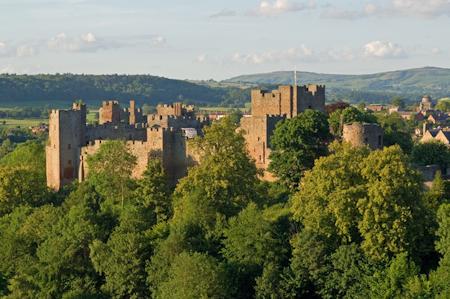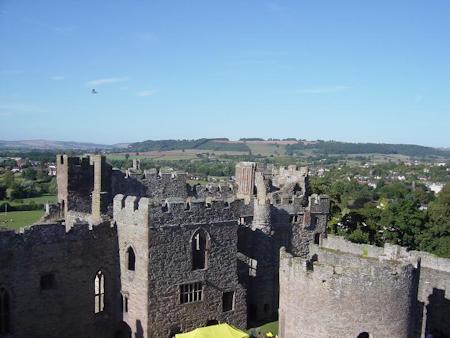
Ludlow Castle
Ludlow Castle is an 11th Century stone castle set on high ground overlooking the River Teme. In medieval times it was a key strategic Marcher Lord fortress on the Welsh Border and it occasionally served as the seat of English government in Wales.
Confused Ownership
Ludlow Castle was built around 1086-1095 by Roger de Lacy. His castle makes up the current day inner bailey. It was an advanced castle for its time with stone construction, towers and a gatehouse. It was protected on the west by the river, a steep bank to the north and rock-cut ditches to the south and east.
Roger rebelled against the king and his lands were confiscated by the king and given to his brother Hugh. Hugh died about a decade later and ownership of the castle reverted to the crown.
After King Henry I's death King Stephen came to the throne. Ludlow Castle was contested between Roger's son Gilbert de Lacy, Josce de Dinan and two neighbouring families. Gilbert took the castle by force in 1138 forcing King Stephen to lay siege to it in 1139. He was unsuccessful and with much of his kingdom in anarchy he withdrew his forces.
During the siege tradition has it that King Stephen saved Prince Henry of Scotland's life. While Stephen was walking outside the castle walls with Henry a grappling hook descended from the Beacon Tower. It caught on Henry's cloak and it was only Stephen's quick thinking in cutting the rope that prevented Henry becoming a captive inside the castle.
At some point in the early 12th Century the unusual circular chapel was built in the courtyard. It was modelled on the Church of the Holy Sepulchre in Jerusalem and is one of only six round churches in England.
Roger Mortimer
By the early 13th Century Ludlow had come into the possession of Roger Mortimer, 1st Earl of March. He added Mortimer's Tower to the west side of the bailey and constructed the main residential buildings on the north side. He also added the 'Hanging Tower' to supplement the four existing towers on the northern wall.
The residential buildings were not greatly altered by subsequent work and they remain as superb examples of 14th Century domestic architecture. They include the main hall with two adjoining wings. The east wing housed the solar while the west wing had the buttery and pantry.
In 1321 Roger was one of the leaders of a baronial revolt against King Edward II. He was eventually successful and forced the king to abdicate. From 1327 to 1330 he was de facto King of England. When King Edward III came of age in 1330 however, Roger was executed and stripped of his titles and lands. The Mortimer family managed to retain Ludlow Castle however.
In 1425 the Mortimer line died out and Ludlow Castle came to the fore of English politics once more. It passed to Richard Plantagenet, 3rd Duke of York. He was the leader of the Yorkist faction in the Wars of the Roses.
Ludlow was one of Richard's power bases and he marched his troops from the castle a few times. In 1459 he had retreated to Ludlow and was forced to face the Lancastrian army at nearby Ludford Bridge. The battle was over before it began as the Yorkist army's leaders ran away via the castle the night before. Defenceless Ludlow Castle was ransacked and looted as a consequence.
Royal Castle and Centre of Government
Despite this, Richard's son became King Edward IV of England and Ludlow became a royal castle once more.
In 1472 Edward sent his two sons to live at Ludlow Castle. The 'Princes in the Tower' spent their early life here, before their uncle Richard, Duke of Gloucester, had them moved to the Tower of London.
Ludlow by this point had become the seat of government for Wales and the border counties. The Council of Wales and the Marches had responsibility for all of modern day Wales as well as the English counties of Shropshire, Herefordshire, Worcestershire and Gloucestershire.
During Elizabethan times the castle was given to Sir Henry Sidney. He added new family apartments between the Great Hall and Mortimer's Tower. His daughter, Mary Sidney, was educated at Ludlow Castle and she went on to become one of most celebrated women writers of the English Renaissance.
The English Civil War saw Ludlow held by the Royalist side. It was besieged by the Parliamentarians for quite some time. It finally surrendered in 1646, although it had sustained considerable damage.
The Council of Wales and the Marches moved to London in the late 1600s and though the castle was used by the Royal Welch Fusiliers for a time it fell into disuse and decay.
Earls of Powis
The Earls of Powis bought Ludlow Castle from the Crown in 1811. They undertook work to stabilise the structure and prevent further decay. The Earl of Powis still owns the castle today.
Ludlow Castle is open to the public all year round. Facilities available include a gift shop, toilets and tea rooms. Guided tours for groups and school groups are available by arrangement.
The castle is host to a number of public events throughout the year including plays and concerts as part of the Ludlow Festival; the Ludlow and Marches Food and Drink Festival as well as smaller fairs and exhibitions. The castle may be closed during some of these so it's worth checking their website before you go.
Parts of the castle are available for venue hire. The castle is well set up to support corporate days and events, private parties and business meetings. In addition Ludlow is available as a wedding venue and has on site accommodation.
Status: Visitor Attraction / Event Venue / Wedding Venue / Accommodation
Owner: Earl of Powis
Tel: +44 (0)1584 873 355
Email: info@ludlowcastle.com
Website: www.ludlowcastle.com
Opening Times: January to February 14th Weekends only 10am-4pm / February 15th to end March Daily 10am-4pm / April to July Daily 10am-5pm / August Daily 10am-6pm / September Daily 10am-5pm / October to December Daily 10am-4pm


Ludlow Castle viewed from Whitcliffe

View inside Ludlow with the round chapel on the right and 14th Century keep on the left.